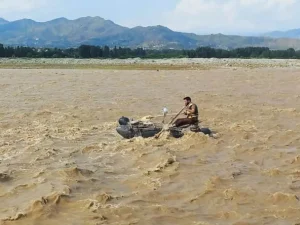Early monsoon rains trigger deadly floods, exposing Pakistan’s unpreparedness amid escalating climate change impacts

ISLAMABAD, June 28 – As monsoon rains arrive earlier than usual, triggering deadly floods and urban chaos, Pakistan’s vulnerability to climate change has once again been laid bare. The unfolding season, forecasted to be longer and wetter than average, has already claimed dozens of lives, inundated homes, and overwhelmed civic infrastructure—raising alarms in a country still recovering from a prolonged heatwave and a dry winter that devastated crops and strained water reserves.
According to the Pakistan Meteorological Department (PMD), the ongoing monsoon is expected to stretch from June through October, with above-normal rainfall predicted across major regions. Punjab may receive 50–60% more rain than average, Balochistan up to 80%, and parts of Khyber Pakhtunkhwa 15–30% more. The National Disaster Management Authority (NDMA) has warned that heavy downpours could trigger glacial lake outburst floods in the north and urban flooding in low-lying areas across the country.
Already, pre-monsoon showers have caused flash floods in the Swat Valley, killing at least 8 people. Roof collapses and electrocution incidents in Punjab and Sindh added to the early toll, with the NDMA confirming over 18 deaths nationwide within a single 24-hour period. Roads were submerged, bridges damaged, and power infrastructure disrupted—echoes of the 2022 catastrophe that displaced over 30 million people and submerged a third of the country.
Experts say these events are no longer anomalies but signs of a deepening climate crisis.
“Pakistan sits among the top 10 countries most affected by climate change, yet contributes less than 1% to global emissions,” said Dr. Fahad Saeed, climate scientist at Climate Analytics. “We are seeing extreme weather events bunching together—drought, heatwaves, early snowmelt, and now excessive rainfall—all in the span of a few months. This pattern is becoming the new normal.”
Earlier this year, a severe heatwave sent temperatures soaring past 48°C in parts of Sindh and Balochistan. That came on the heels of a parched winter that saw rainfall drop 40% below average, leaving the soil dry and less absorbent—conditions that make flash flooding more likely when the rains come.
Despite mounting risks, Pakistan’s infrastructure and institutional response mechanisms remain woefully underprepared. In cities like Karachi, Lahore, and Rawalpindi, clogged storm drains and rampant urbanization have led to repeated waterlogging. In the northern districts, fragile slopes and inadequate riverbank protections increase the threat of landslides and washouts.
While the NDMA and provincial governments have issued alerts, conducted drills, and directed local authorities to clear stormwater drains, implementation on the ground has been patchy. “Preparedness is improving on paper, but the delivery is still reactive rather than anticipatory,” said Ayesha Bano, a disaster management expert based in Islamabad.
The recurring monsoon devastation is also having long-term impacts on food security and livelihoods. Farmers in southern Punjab and Sindh, already suffering from water shortages and heat-damaged crops, now face the risk of losing their summer harvest to floods.
As Pakistan awaits international climate financing under the Loss and Damage Fund and other global mechanisms, experts warn that the window to climate-proof its cities, river systems, and governance structures is closing rapidly.
“Climate change is not coming—it’s already here,” said Dr. Saeed. “Every monsoon now is a test Pakistan cannot afford to fail.”
 Radio News Network Radio News Network
Radio News Network Radio News Network
